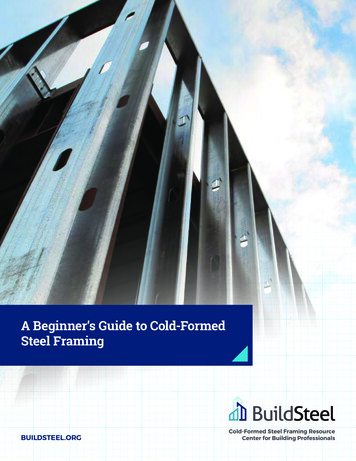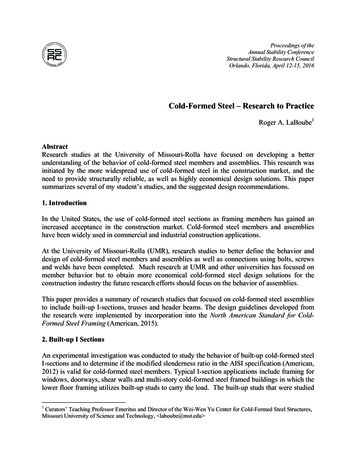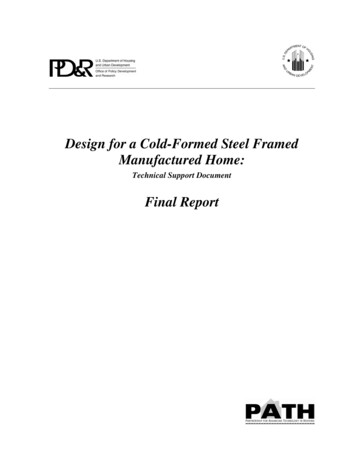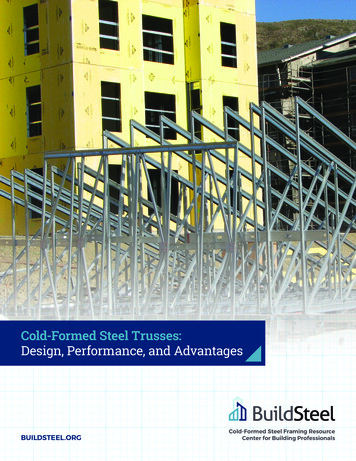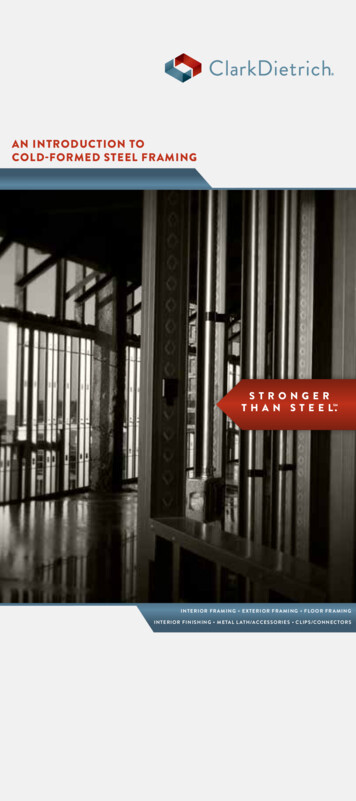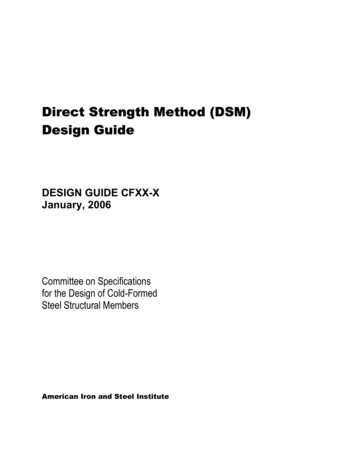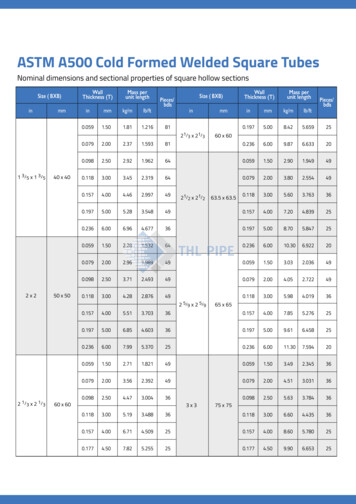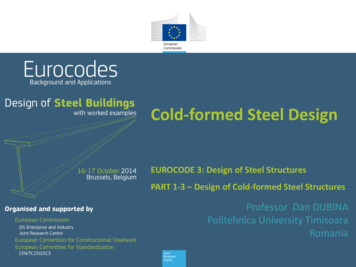
Transcription
Cold-formed Steel DesignEUROCODE 3: Design of Steel StructuresPART 1-3 – Design of Cold-formed Steel StructuresProfessor Dan DUBINAPolitehnica University TimisoaraRomania
Cold Formed Steel DesignContents Introduction Peculiar characteristics Resistance of Sections Resistance of Members Conceptual Design (case study)
Background and peculiaritiesIntroductionGeneralCollection of different cold-formed steelsections shapes (Trebilcock, 1994)
Background and peculiaritiesIntroductionGeneralCollection of different cold-formed steelsections shapes (Trebilcock, 1994)Collection of different cold-formedsteel sections shapes
Background and peculiaritiesIntroductionTypes of cold-formed steel sections Typical forms of sections for cold-formed structural membersSingle open sections
Background and peculiaritiesIntroductionTypes of cold-formed steel sections Typical forms of sections for cold-formed structural membersOpen built-up sectionsClosed built-up sectionsSingle open sections
Background and peculiaritiesIntroductionTypes of cold-formed steel sections Profiled sheets and linear trays sections
Background and peculiaritiesIntroductionAdvantages Advantages of Using Cold-Formed Steel Sections Lightness;High strength and stiffness;Ability to provide long spans;Easy prefabrication and mass production;Fast and easy erection and installation;Substantial elimination of delay due to the weather;More accurate detailing;Non-shrinking and non-creeping at ambient temperatures;Form work unneeded;Termite-proof and rat-proof;Uniform quality;Economy in transportation and handling;Non combustibility;Recyclable material.
Background and peculiaritiesIntroductionManufacturing technologies Roll forming;Folding;Press braking
Background and peculiaritiesIntroductionManufacturing technologies STARTRoll forming;Folding;Press braking123456Flat sheetFinishedsection1625432136 45564321
Background and peculiaritiesIntroductionManufacturing technologies STARTRoll forming;Folding;Press braking123456Flat sheetFinishedsection1625432136 45564321
Background and peculiaritiesIntroductionManufacturing technologies STARTRoll forming;Folding;Press braking123456Flat sheetFinishedsection1625432136 45564321
Background and peculiaritiesIntroductionManufacturing technologies STARTRoll forming;Folding;Press braking123456Flat sheetFinishedsection1625432136 45564321
Background and peculiaritiesIntroductionManufacturing technologies STARTRoll forming;Folding;Press braking123456Flat sheetFinishedsection1625432136 45564321
Background and peculiaritiesIntroductionManufacturing technologies STARTRoll forming;Folding;Press braking123456Flat sheetFinishedsection1625432136 45564321
Background and peculiaritiesIntroductionManufacturing technologies Roll forming;Folding;Press braking
Background and peculiaritiesIntroductionManufacturing technologies Roll forming;Folding;Press braking
Background and peculiaritiesIntroductionManufacturing technologies Roll forming;Folding;Press braking
Background and peculiaritiesIntroductionPeculiar Characteristics of Cold-Formed Steel Sections Imperfections in Thin-Walled Cold-Formed Steel MembersmecanicalLoading eccentricitiesSupport eccentricitiesIMPERFECTIONS
Background and peculiaritiesIntroductionPeculiar Characteristics of Cold-Formed Steel Sections Imperfections in Thin-Walled Cold-Formed Steel MembersmecanicalLoading eccentricitiesSupport eccentricitiesIMPERFECTIONSmaterialForming processYielding strengthResidual stresses
Background and peculiaritiesIntroductionPeculiar Characteristics of Cold-Formed Steel Sections Imperfections in Thin-Walled Cold-Formed Steel MembersmecanicalLoading eccentricitiesSupport eccentricitiesIMPERFECTIONSmaterialForming processYielding strengthResidual stressesLocal (sectional)geometricGlobal (member)
Background and peculiaritiesIntroductionPeculiar Characteristics of Cold-Formed Steel Sections Effect of Strain Hardening and Strain Aging on Stress-Strain CharacteristicsIncrease in F yIncrease in F uStrain agingDAStrain agingCAStrainhardeningDuctility afterstrain agingBCDuctility afterstrain hardeningVirgin ductilityStrain
Background and peculiaritiesIntroductionPeculiar Characteristics of Cold-Formed Steel Sections Effect of Strain Hardening and Strain Aging on Stress-Strain CharacteristicsIncrease in F yIncrease in F uStrain agingDAStrain agingCAStrainhardeningDuctility afterstrain agingBCDuctility afterstrain hardeningVirgin ductilityStrain
Background and peculiaritiesIntroductionPeculiar Characteristics of Cold-Formed Steel Sections Increase of the Yield Strength and Ultimate Strength Due to Cold-Forming
Background and peculiaritiesIntroductionPeculiar Characteristics of Cold-Formed Steel Sections Increase of the Yield Strength and Ultimate Strength Due to Cold-FormingForming methodCold rollingCornerFlangeYield strengthfy Ultimate strengthfu Forming methodPress brackingCornerFlangeYield strengthfy -Ultimate strengthfu -
Background and peculiaritiesIntroductionPeculiar Characteristics of Cold-Formed Steel Sections Flexural Residual Stresses Obtained at the “POLITEHNICA” University ofTimisoara27%23%25%14%12%24%39%15%17%24%26%12%
Background and peculiaritiesIntroductionPeculiar Characteristics of Cold-Formed Steel Sections Flexural Residual Stresses Obtained at the “POLITEHNICA” University ofTimisoaraSchafer and Pekoz23%27%33%39%27%23%25%14%12%27%8%17%23%33%(a) Roll-Formed8%(b) Press24%39%15%17%39%17%24%26%12%(a) Roll-Formed(b) Press-Braked
Background and peculiaritiesIntroductionPeculiar Characteristics of Cold-Formed Steel Sections Type and Magnitude of Residual Stress In Steel SectionsForming methodMembraneresidual stresses(srm)Flexural residualstresses (srf)HotrollingCold formingColdPressrollingbrakinghighlowlowlowhighlow
Background and peculiaritiesIntroductionPeculiar Problems of Cold-Formed Steel Design Buckling modes for a lipped channel in compressionSingle modes:(a) local (L);(b) distortional (D);(c) flexural (F);(d) torsional (T);(e) flexural-torsional (FT).a)b)c)d)e)Coupled (interactive) modes:(f) L D;(g) F L;(h) F D;(i) FT L;(j) FT D;(k) F FTf)g)h)i)j)k)
Background and peculiaritiesIntroductionPeculiar Problems of Cold-Formed Steel Design Buckling strength versus half-wavelength for a lipped channel incompression (Hancock, 2001)800Local modeDistorsional modeBuckling Strength (Mpa)700600Timoshenko FlexuralTorsional Buckling500400AB300All modes (coupled) buckling 0100010000
Background and peculiaritiesIntroductionPeculiar Problems of Cold-Formed Steel Design Behaviour of compression bar(a) slender tick-walled (hot-rolled section)(b) thin-walled (cold-formed section)
Background and peculiaritiesIntroductionPeculiar Problems of Cold-Formed Steel Design Failure Mode of a Lipped Channel In Compression
Background and peculiaritiesIntroductionPeculiar Problems of Cold-Formed Steel Design Failure Mode of a Lipped Channel In Compression
Background and peculiaritiesIntroductionPeculiar Problems of Cold-Formed Steel Design Effect of local buckling on the member capacityN N/Npl(Npl A fy)NE (Euler)Erosion due toimperfections local buckling effectErosion due toimperfections1.0N Aeff/A 1Full section (A)Reduced section (Aeff)00.21.02.0Bar slenderness ( )
Background and peculiaritiesIntroductionPeculiar Problems of Cold-Formed Steel Design Erosion Concept – Erosion levelsLoadNcrmode 1mode 2Eroziunemaximă, yNuCoupling pointmod real
Background and peculiaritiesIntroductionPeculiar Problems of Cold-Formed Steel Design Erosion Concept – Erosion levelsLoadNcrmode 1mode 2Eroziunemaximă, yNuCoupling pointNu Ncr ψ–I: Weak interaction (WI), ψ 0.1II: Moderate interaction (MI), 0.1 ψ 0.3III: Strong interaction (SI), 0.3 ψ 0.5IV: Very Strong interaction (VSI), ψ 0.5mod real
Background and peculiaritiesIntroductionPeculiar Problems of Cold-Formed Steel Design Erosion Concept – Erosion levelsLoadNcrmode 1mode 2Eroziunemaximă, yNuCoupling pointNu Ncr ψ–mod realI: Weak interaction (WI), ψ 0.1II: Moderate interaction (MI), 0.1 ψ 0.3III: Strong interaction (SI), 0.3 ψ 0.5IV: Very Strong interaction (VSI), ψ 0.5Thin walledmembers
Background and peculiaritiesIntroductionPeculiar Problems of Cold-Formed Steel Design Open sections highly sensitive to torsional Reduced torsional stiffenessDeplasarea centruluide tăiere dinîncovoiereRăsucireÎncărcare axialăîn centrul degreutateFlambaj prinîncovoiereFlambaj prinîncovoiere-răsucire
Background and peculiaritiesIntroductionPeculiar Problems of Cold-Formed Steel Design Web Crippling (Critical Problems) In cold-formed steel design, it is often not practical to provide load bearingand end bearing stiffeners. This is always the case in continuous sheeting anddecking spanning several support points.The depth-to-thickness ratios of the webs of cold-formed members areusually larger than hot-rolled structural members.In many cases, the webs are inclined rather than vertical.The intermediate element between the flange, on which the load is applied,and the web of a cold-formed member usually consists of a bend of finiteradius. Hence the load is applied eccentrically from the web.
Background and peculiaritiesIntroductionPeculiar Problems of Cold-Formed Steel Design CONNECTIONS Thin-to-thinThin-to-thick or thinto-hot rolledself-drilling, selftapping screws;blind rivets;press-joints;single-flare Vwelds;spot welds;seam welding;adhesivebonding. Special Types of connectionsThick-to-thick orthick-to-hotrolledself-drilling, self- bolts;tapping screws; arc welds.fired pins;bolts;arc spot puddlewelds;adhesivebonding.
Background and peculiaritiesIntroductionPeculiar Problems of Cold-Formed Steel Design CONNECTIONS Thin-to-thinThin-to-thick or thinto-hot rolledself-drilling, selftapping screws;blind rivets;press-joints;single-flare Vwelds;spot welds;seam welding;adhesivebonding. Thick-to-thick orthick-to-hotrolledself-drilling, self- bolts;tapping screws; arc welds.fired pins;bolts;arc spot puddlewelds;adhesivebonding. Special Types of connections Connections Typology (based on the material) metal-to-metal connectionsmetal-to-sheathing (wood-based and gypsum-based sheathings) connectionsmetal-to-concrete connections.
Background and peculiaritiesIntroductionPeculiar Problems of Cold-Formed Steel Design
Background and peculiaritiesIntroductionPeculiar Problems of Cold-Formed Steel DesignUsual mechanical fasters
Background and peculiaritiesIntroductionPeculiar Problems of Cold-Formed Steel Design Ductility and Plastic Design : Cold-Formed Steel Sections are , usually,Class 4 !MomentMplMel1234f
Background and peculiaritiesIntroductionBasis of Design Generalities
Background and peculiaritiesIntroductionBasis of Design Limit State Design EN1990 (CEN, 2002a) All the separate conditions that make a structure unfit for use are taken intoaccount. These are the separate limit states;The design is based on the actual behaviour of materials and performance ofstructures and members in service;Ideally, design should be based on statistical methods with a smallprobability of the structure reaching a limit state.ULS – Specific Thin Walled Issueslocal instability and strength of sectionsinteractive instability and influenceof specific imperfectionconnecting technology and related design proceduresreduced capacity with reference to ductility,plastic design and seismic resistancefire resistance
Background and peculiaritiesIntroductionBasis of Design Actions on Structures. Combinations of Actions (EN1991) Verification at the Ultimate Limit StateVerification at the Serviceability Limit State safety factors according to EN1990 (as for hot rolled steel)factors: γM0 – resistance of cross sections to excessive yielding includinglocal and distortional buckling γM1 – resistance of members and sheeting where failure is causedby global buckling γM2 – resistance of net sections at fastener holes
Background and peculiaritiesIntroductionBasis of Design Actions on Structures. Combinations of Actions (EN1991) Verification at the Ultimate Limit StateVerification at the Serviceability Limit State safety factors according to EN1990 (as for hot rolled steel)factors: γM0 – resistance of cross sections to excessive yielding includinglocal and distortional buckling γM1 – resistance of members and sheeting where failure is causedby global buckling γM2 – resistance of net sections at fastener holesRecommended values(EN1993 – 1 – 3)γM0 1.0γM1 1.0γM2 1.25
Background and peculiaritiesIntroductionBasis of Design Materials (EN1993–1–3)
Background and peculiaritiesIntroductionBasis of Design Materials (EN1993–1–3)
Background and peculiaritiesIntroductionBasis of Design Materials (EN1993–1–3) yield strength fyb and ultimate tensile strength fu should be obtained: either by adopting the values fy Reh (upper yield strength) or Rp0,2(proof strength) and fu Rm (tensile strength) direct from productstandards by using the values given in Table 2.7a or b of EN1993–1–3 by appropriate tests (EN10002-1)
Background and peculiaritiesIntroductionBasis of Design Materials (EN1993–1–3) yield strength fyb and ultimate tensile strength fu should be obtained: either by adopting the values fy Reh (upper yield strength) or Rp0,2(proof strength) and fu Rm (tensile strength) direct from productstandards by using the values given in Table 2.7a or b of EN1993–1–3 by appropriate tests (EN10002-1) properties of cold-formed sections and sheeting modification of the stress-strain curve of the steel (increase of the yieldstrength is due to strain hardening, the increase of the ultimate strengthis related to strain aging) coiling, uncoiling, cold reducing and the cold-forming processused for cross section resistance of an axially loaded tension member buckling resistance of members with fully effective cross section
Background and peculiaritiesIntroductionBasis of Design Methods of Analysis and Design Methods of analysis – Global frame analysisFinite Element Methods (FEM) for analysis and designDesign assisted by testing determine the distribution of the internal forces and the correspondingdeformations in a structure subjected to a specified loading global analysis of frames is conducted on a model based on manyassumptions including those for the structural model, the geometric andmaterial behaviour of the structure, of its sections /members andjoints. (1) First-order elastic analysis; (2) Second-order elastic analysis; (3) Elastic-perfectly plastic analysis (Second-order theory); (4) Elasto-plastic analysis (second-order theory); (5) Rigid-plastic analysis (first-order theory)
Background and peculiaritiesIntroductionBasis of Design Methods of Analysis and Design Methods of analysis – Global frame analysisFinite Element Methods (FEM) for analysis and designDesign assisted by testing guidance can be found in Annex C of EN1993-1-5The FE-modelling may be carried out either for: (1) the component as a whole (2) a substructure as a part of the whole structure. Also, design ofmembers and details can be assisted by numerical simulations (e.g.numerical testing). Sectional imperfections for Local and Distortional Buckling modesd2d1
Background and peculiaritiesIntroductionBasis of Design Design assisted by testing – may be undertaken under any of thefollowing circumstances: if it is desired to prove the validity and adequacy of an analytical procedure;if it is desired to produce resistance tables based on tests, or on acombination of testing and analysis;if it is desired to take into account practical factors that might alter theperformance of a structure, but are not addressed by the relevant analysismethod for design by calculation. ECCS No 124 -2008: Testing of connections with mechanical fasteners insheeting and Sections ECCS no. 127-2009 Testing and design of fastenings in Sandwich panels En 15129 -2009: Steel static storage systems – Adjustable pallet rackingsystems EN 1990, Annex D : design assisted by testing ( reliability and strength) EN 1993-1-3, Ch 9, Annex A
Background and peculiaritiesIntroductionBasis of Design Design assisted by testing – may be undertaken under any of thefollowing circumstances: if it is desired to prove the validity and adequacy of an analytical procedure;if it is desired to produce resistance tables based on tests, or on acombination of testing and analysis;if it is desired to take into account practical factors that might alter theperformance of a structure, but are not addressed by the relevant analysismethod for design by calculation.
Resistance of sectionsGeneral
Resistance of sectionsBehaviour and Resistance of Cross SectionProperties of gross-cross section Dimensional limits of component walls of CFS
Resistance of sectionsBehaviour and Resistance of Cross SectionProperties of gross-cross section Dimensional limits of component walls of CFS
Resistance of sectionsBehaviour and Resistance of Cross SectionProperties of gross-cross section Dimensional limits of component walls of CFS
Resistance of sectionsBehaviour and Resistance of Cross SectionProperties of gross-cross section Modelling of cross-section for analysis
Resistance of sectionsBehaviour and Resistance of Cross SectionEffect of wall slenderness :Flange curling
Resistance of sectionsBehaviour and Resistance of Cross SectionEffect of wall slenderness :Flange curling
Resistance of sectionsBehaviour and Resistance of Cross SectionEffect of wall slenderness :Flange curling
Resistance of sectionsBehaviour and Resistance of Cross SectionFlange curling
Resistance of sectionsBehaviour and Resistance of Cross SectionFlange curling
Resistance of sectionsBehaviour and Resistance of Cross SectionFlange curling
Resistance of sectionsBehaviour and Resistance of Cross SectionWeb Crippling Local Transverse Forces – Cross sections with a single unstiffened web
Resistance of sectionsBehaviour and Resistance of Cross SectionWeb Crippling Local Transverse Forces – Cross sections with a single unstiffened web
Resistance of sectionsBehaviour and Resistance of Cross SectionLocal Buckling and Distortional Buckling Sectional buckling modes in thin-walled sections
Resistance of sectionsBehaviour and Resistance of Cross SectionLocal Buckling Elastic buckling of thin plates
Resistance of sectionsBehaviour and Resistance of Cross SectionLocal Buckling Elastic buckling of thin plates
Resistance of sectionsBehaviour and Resistance of Cross SectionLocal Buckling Elastic buckling of thin plates
Resistance of sectionsBehaviour and Resistance of Cross SectionLocal Buckling Elastic buckling of thin plates
Resistance of sectionsBehaviour and Resistance of Cross SectionLocal Buckling Elastic buckling of thin plates
Resistance of sectionsBehaviour and Resistance of Cross SectionLocal Buckling Elastic buckling of thin plates
Resistance of sectionsBehaviour and Resistance of Cross SectionLocal Buckling Elastic buckling of thin plates
Resistance of sectionsBehaviour and Resistance of Cross SectionLocal Buckling Elastic buckling of thin plates
Resistance of sectionsBehaviour and Resistance of Cross SectionLocal Buckling Elastic buckling of thin plates
Resistance of sectionsBehaviour and Resistance of Cross SectionLocal Buckling Elastic buckling of thin plates
Resistance of sectionsBehaviour and Resistance of Cross SectionLocal Buckling Elastic buckling of thin plates
Resistance of sectionsBehaviour and Resistance of Cross SectionLocal Buckling Elastic buckling of thin plates
Resistance of sectionsBehaviour and Resistance of Cross SectionDistortional buckling: analytical methods
Resistance of sectionsBehaviour and Resistance of Cross SectionDistortional buckling: analytical methods
Resistance of sectionsBehaviour and Resistance of Cross SectionDistortional buckling: analytical methods
Resistance of sectionsBehaviour and Resistance of Cross SectionDistortional buckling: analytical methods The method given in EN1993-1-3:2006
Resistance of sectionsBehaviour and Resistance of Cross SectionDistortional buckling: analytical methods The method given in EN1993-1-3:2006
Resistance of sectionsBehaviour and Resistance of Cross SectionDistortional buckling: analytical methods The method given in EN1993-1-3:2006
Resistance of sectionsBehaviour and Resistance of Cross SectionDesign Against Local and Distortional Buckling (EN1993-1-3) General
Resistance of sectionsBehaviour and Resistance of Cross SectionDesign Against Local and Distortional Buckling (EN1993-1-3) General
Resistance of sectionsBehaviour and Resistance of Cross SectionDesign Against Local and Distortional Buckling (EN1993-1-3) Plane elements without stiffeners (no interaction)
Resistance of sectionsBehaviour and Resistance of Cross SectionDesign Against Local and Distortional Buckling (EN1993-1-3) Plane elements without stiffeners
Resistance of sectionsBehaviour and Resistance of Cross SectionDesign Against Local and Distortional Buckling (EN1993-1-3) Plane elements without stiffeners
Resistance of sectionsBehaviour and Resistance of Cross SectionDesign Against Local and Distortional Buckling (EN1993-1-3)Plane elements with edge or intermediate stiffeners (elastic interaction)
Resistance of sectionsBehaviour and Resistance of Cross SectionDesign Against Local and Distortional Buckling (EN1993-1-3)Plane elements with edge or intermediate stiffeners (elastic interaction)
Resistance of sectionsBehaviour and Resistance of Cross SectionDesign Against Local and Distortional Buckling (EN1993-1-3)Plane elements with edge or intermediate stiffeners (elastic interaction)
Resistance of sectionsBehaviour and Resistance of Cross SectionDesign Against Local and Distortional Buckling (EN1993-1-3) Plane elements with edge or intermediate stiffeners
Resistance of sectionsBehaviour and Resistance of Cross SectionDesign Against Local and Distortional Buckling (EN1993-1-3) Plane elements with edge or intermediate stiffeners
Resistance of sectionsBehaviour and Resistance of Cross SectionDesign Against Local and Distortional Buckling (EN1993-1-3) Plane elements with edge or intermediate stiffeners
Resistance of sectionsBehaviour and Resistance of Cross SectionDesign Against Local and Distortional Buckling (EN1993-1-3) Plane elements with edge stiffeners – conditions
Resistance of sectionsBehaviour and Resistance of Cross SectionDesign Against Local and Distortional Buckling (EN1993-1-3) Plane elements with edge stiffeners – conditions
Resistance of sectionsBehaviour and Resistance of Cross SectionDesign Against Local and Distortional Buckling (EN1993-1-3) Plane elements with edge stiffeners – general procedure
Resistance of sectionsBehaviour and Resistance of Cross SectionDesign Against Local and Distortional Buckling (EN1993-1-3) Plane elements with edge stiffeners – general procedure
Resistance of sectionsBehaviour and Resistance of Cross SectionDesign Against Local and Distortional Buckling (EN1993-1-3) Plane elements with edge stiffeners – general procedure
Resistance of sectionsBehaviour and Resistance of Cross SectionDesign Against Local and Distortional Buckling (EN1993-1-3) Plane elements with edge stiffeners – general procedure
Resistance of sectionsBehaviour and Resistance of Cross SectionDesign Against Local and Distortional Buckling (EN1993-1-3) EXAMPLE 2: Calculation of effective section properties for a coldformed lipped channel section in compression
Resistance of sectionsBehaviour and Resistance of Cross SectionEXAMPLE 2: CFS in compression EXAMPLE 2: Calculation of effective section properties for a coldformed lipped channel section in compression
Resistance of sectionsBehaviour and Resistance of Cross SectionEXAMPLE 2: CFS in compression Effective section properties of the flange and lip in compression
Resistance of sectionsBehaviour and Resistance of Cross SectionEXAMPLE 2: CFS in compression Effective section properties
Resistance of sectionsBehaviour and Resistance of Cross SectionEXAMPLE 2: CFS in compression Effective section properties
Resistance of sectionsBehaviour and Resistance of Cross SectionDesign Against Local and Distortional Buckling (EN1993-1-3) EXAMPLE 1: Calculation of effective section properties for a coldformed lipped channel section in bending
Resistance of sectionsBehaviour and Resistance of Cross SectionEXAMPLE 1: CFS in bending Effective section properties
Resistance of sectionsBehaviour and Resistance of Cross SectionEXAMPLE 1: CFS in bending Effective section properties
Resistance of sectionsBehaviour and Resistance of Cross SectionEXAMPLE 1: CFS in bending Effective section properties
Resistance of sectionsBehaviour and Resistance of Cross SectionEXAMPLE 1: CFS in bending Effective section properties
Resistance of sectionsBehaviour and Resistance of Cross SectionEXAMPLE 1: CFS in bending Effective section properties
Resistance of sectionsBehaviour and Resistance of Cross SectionEXAMPLE 1: CFS in bending Effective section properties
Resistance of sectionsBehaviour and Resistance of Cross SectionResistance of Cross Sections Bending Moment - Elastic and elastoplastic resistance withyielding at the tension flange only
Resistance of sectionsBehaviour and Resistance of Cross SectionResistance of Cross Sections Bending Moment - Elastic and elastoplastic resistance withyielding at the tension flange only
Resistance of sectionsBehaviour and Resistance of Cross SectionResistance of Cross Sections – Bending Moment Example – Design of a cold-formed steel member in bending
Resistance of sectionsBehaviour and Resistance of Cross SectionResistance of Cross Sections – Bending Moment Example – Design of a cold-formed steel member in bending
Resistance of sectionsBehaviour and Resistance of Cross SectionResistance of Cross SectionsLipped Channel Beam Calculation of geometrical properties of effective section :beff,i ; Aeff,i Ieff,i , Weff,i Cecking for Bending moment, MRd Checking for Shear, VRd Checking for transverse force (web crippling), RRd Checking for interaction MRd VRd Checking for interaction MRd RRd
Resistance of sectionsBehaviour and Resistance of Cross SectionResistance of Cross Sections – Bending Moment Example – Design of a cold-formed steel member in bending
Resistance of sectionsBehaviour and Resistance of Cross SectionResistance of Cross Sections – Bending Moment Example – Design of a cold-formed steel member in bending
Resistance of sectionsBehaviour and Resistance of Cross SectionResistance of Cross Sections – Bending Moment Example – Design of a cold-formed steel member in bending
Resistance of membersCompression members Buckling resistance of uniform members in compression.Design according to EN1993-1-3
Resistance of membersCompression members Buckling resistance of uniform members in compression.Design according to EN1993-1-3
Resistance of membersCompression members Buckling resistance of uniform members in compression.Design according to EN1993-1-3
Resistance of membersCompression members Buckling resistance of uniform members in compression.Design according to EN1993-1-3
Resistance of membersCompression members Buckling resistance of uniform members in compression.Design according to EN1993-1-3
Resistance of membersCompression members Buckling resistance of uniform members in compression.Design according to EN1993-1-3
Resistance of membersCompression members Buckling resistance of uniform members in compression.Design according to EN1993-1-3
Resistance of membersCompression members Buckling resistance of uniform members in compression.Design according to EN1993-1-3Flexural buckling
Resistance of membersCompression members Buckling resistance of uniform members in compression.Design according to EN1993-1-3Flexural buckling
Resistance of membersCompression members Buckling resistance of uniform members in compression.Design according to EN1993-1-3Torsional and Flexural-Torsional buckling
Resistance of membersCompression members Example – Design of an internal wall stud in compression
Resistance of membersCompression members Example – Design of an internal wall stud in compression
Resistance of membersCompression members Example – Design of an internal wall stud in compression
Resistance of membersCompression members Example – Design of an internal wall stud in compression
Resistance of membersCompression members Example – Design of an internal wall stud in compression
Resistance of membersCompression members Example – Design of an internal wall stud in compression
Resistance of membersCompression members Example – Design of an internal wall stud in compression
Resistance of membersCompression members Example – Design of an internal wall stud in compression
Resistance of membersCompression members Example – Design of an internal wall stud in compression
Resistance of membersCompression members Example – Design of an internal wall stud in compression
Resistance of membersCompression members Example – Design of an internal wall stud in compression
Resistance of membersCompression members Example – Design of an internal wall stud in compression
Resistance of membersCompression members Example – Design of an internal wall stud in compression
Resistance of membersCompression members Example
Ductility and Plastic Design : Cold-Formed Steel Sections are , usually, Class 4 ! Introduction Peculiar Problems of

